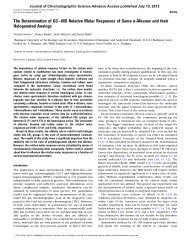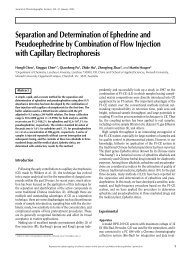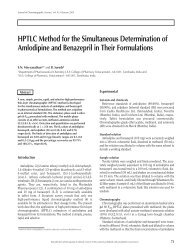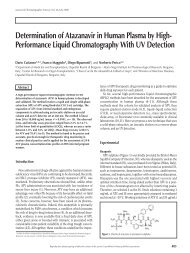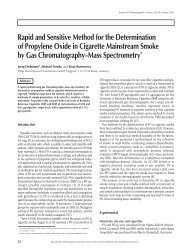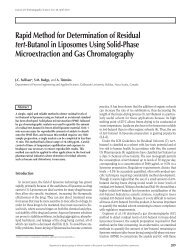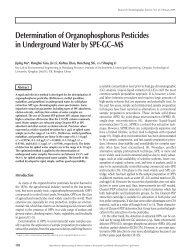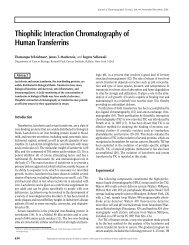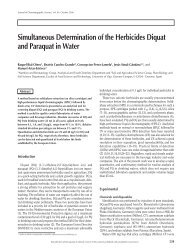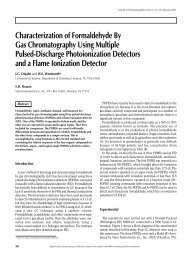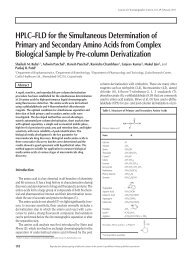Ecdysteroid Glycosides - Journal of Chromatographic Science
Ecdysteroid Glycosides - Journal of Chromatographic Science
Ecdysteroid Glycosides - Journal of Chromatographic Science
Create successful ePaper yourself
Turn your PDF publications into a flip-book with our unique Google optimized e-Paper software.
<strong>Journal</strong> <strong>of</strong> <strong>Chromatographic</strong> <strong>Science</strong>, Vol. 43, March 2005<br />
<strong>Ecdysteroid</strong> <strong>Glycosides</strong>: Identification, <strong>Chromatographic</strong><br />
Properties, and Biological Significance<br />
Annick Maria1 , Jean-Pierre Girault2 , Ziyadilla Saatov3 , Juraj Harmatha4 , Laurence Dinan5 , and René Lafont1 1Laboratoire d’Endocrinologie Moléculaire et Évolution, EA 3501 & IFR83, Université Pierre et Marie Curie, 7 Quai St. Bernard, Case 29,<br />
75252 Paris 05, France; 2Université René Descartes, Laboratoire de Chimie et Biochimie Pharmacologiques et Toxicologiques, CNRS UMR<br />
8601, 45 rue des Saints-Pères, F-75270 Paris Cedex 05 France; 3Institute <strong>of</strong> Chemistry <strong>of</strong> Plant Substances, 700170 Tashkent, Uzbekistan;<br />
4Institute <strong>of</strong> Organic Chemistry and Biochemistry, Academy <strong>of</strong> <strong>Science</strong>s, Flemingovo nám. 2, 166 10 Prague, Czech Republic; and 5Hatherly Laboratories, Department <strong>of</strong> Biological <strong>Science</strong>s, University <strong>of</strong> Exeter, Prince <strong>of</strong> Wales Road, Exeter, Devon EX4 4PS, U.K.<br />
Abstract<br />
<strong>Ecdysteroid</strong> glycosides are found in both animals and plants.<br />
The chromatographic behavior <strong>of</strong> these molecules is characteristic,<br />
as they appear much more polar than their corresponding free<br />
aglycones when analyzed by normal-phase high-performance<br />
liquid chromatography (HPLC), whereas the presence <strong>of</strong><br />
glycosidic moieties has a very limited (if any) impact on polarity<br />
when using reversed-phase HPLC. Biological activity is greatly<br />
reduced because the presence <strong>of</strong> this bulky substituent probably<br />
impairs the interaction with ecdysteroid receptor(s). 2-Deoxy-<br />
20-hydroxyecdysone 22-O-β-D-glucopyranoside, which has<br />
been isolated from the dried aerial parts <strong>of</strong> Silene nutans<br />
(Caryophyllaceae), is used as a model compound to describe the<br />
rationale <strong>of</strong> ecdysteroid glycoside purification and identification.<br />
Introduction<br />
<strong>Ecdysteroid</strong>s represent a large family <strong>of</strong> polyhydroxylated<br />
steroids found in both animals and plants (1–4). In plants, these<br />
secondary metabolites are thought to provide protection against<br />
nonadapted insect species and possibly also soil nematodes (5–7).<br />
<strong>Ecdysteroid</strong>s also display a wide array <strong>of</strong> pharmacological effects<br />
in mammals, and they are present in large amounts in several<br />
plants used in traditional medicine (8,9).<br />
<strong>Ecdysteroid</strong>s have been found in many plant species belonging<br />
to the Caryophyllaceae, and the genus Silene consists <strong>of</strong> many<br />
species <strong>of</strong> interest in this respect (10–12). When plants contain<br />
ecdysteroids, they usually contain a complex mixture <strong>of</strong> closely<br />
related molecules (4,10,11), among which there may be a significant<br />
amount <strong>of</strong> ecdysteroid glycosides. A list <strong>of</strong> the presently<br />
known ecdysteroid glycosides is given in Table I. The Silene genus<br />
has in fact been the source <strong>of</strong> nearly half <strong>of</strong> the currently isolated<br />
ecdysteroid glycosides.<br />
<strong>Ecdysteroid</strong> glycosides are not restricted to plants, as such conjugates<br />
have also been identified from insects and a nematode [in<br />
the latter case, as conjugated metabolites <strong>of</strong> exogenously applied<br />
ecdysone (37,38)]. An ecdysteroid glucosyl-transferase is also present<br />
in baculoviruses [e.g., Autographa californica (40)], which<br />
can disrupt ecdysteroid-related processes in infested insects.<br />
A chemical synthesis <strong>of</strong> ecdysteroid glucosides has been<br />
described (41), making such derivatives readily available for the<br />
assessment <strong>of</strong> their biological activity (42). The purification and<br />
analysis <strong>of</strong> ecdysteroid glycosides raises specific problems, and the<br />
present aim is to describe an efficient method for the isolation and<br />
identification <strong>of</strong> such derivatives from various biological sources.<br />
Experimental<br />
Reference compounds used<br />
Most ecdysteroids used in the present study were isolated by the<br />
authors’ laboratories from various plant sources (Silene otites,<br />
Silene nutans, Silene brahuica, and Limnanthes douglasii)<br />
(Table I). The various glucosides <strong>of</strong> 20-hydroxyecdysone were prepared<br />
by chemical synthesis (41). Reference 26-hydroxyecdysone<br />
was isolated from Manduca sexta eggs.<br />
High-performance liquid chromatographic systems<br />
Analytical experiments described in Table II were performed<br />
with a Spectra Series high-performance liquid chromatographic<br />
(HPLC) equipment (P200 pump, UV 100 detector) (Thermo-<br />
Separations Products, Les Ulis, France). Four isocratic HPLC systems<br />
have been used in the present study. Reversed-phase HPLC<br />
used a Spherisorb 5ODS-2 column (25-cm length, 4.6-mm i.d., 5-<br />
µm particle size) (AIT Chromato, Le Mesnil le Roi, France) eluted<br />
at 1 mL/min with either 45% MeOH in water (System RP1) or<br />
18% ACN–iPrOH (5:2 v/v) in 0.1% trifluoroacetic acid (system<br />
RP2). The normal-phase HPLC system included a Kromasil 3.5<br />
µm (25-cm length, 4.6-mm i.d.) (AIT Chromato) eluted at 1<br />
mL/min with either dichloromethane–isopro-panol–water<br />
(25:10:1 v/v/v, System NP1) or cyclohexane–isopropanol–water<br />
(85:40:3 v/v/v, System NP2).<br />
Reproduction (photocopying) <strong>of</strong> editorial content <strong>of</strong> this journal is prohibited without publisher’s permission.<br />
149
Bioassay<br />
<strong>Ecdysteroid</strong> agonist and antagonist activities <strong>of</strong> the ecdysteroid<br />
glycosides were determined using the Drosophila melanogaster<br />
B II cell assay, as described previously (43). None <strong>of</strong> the compounds<br />
possessed antagonist activity.<br />
Spectroscopic methods<br />
MS spectra were recorded on an MS 700 spectrometer (Jeol<br />
Europe, Croissy sur Seine, France) equipped with a direct inlet<br />
probe. Spectra were recorded in the chemical ionization–desorp-<br />
Table I. Occurrence <strong>of</strong> <strong>Ecdysteroid</strong> <strong>Glycosides</strong>*<br />
Origin Compound Reference<br />
Plants<br />
Silene brahuica Sileneoside A = 20E 22-gal 13<br />
Silene brahuica Sileneoside B = 20E 3,22-digal 14<br />
Silene brahuica Sileneoside C = IntA 22-gal 15<br />
Silene brahuica Sileneoside D = 20E 3-gal 16<br />
Silene brahuica Sileneoside F = Brahuisterone 3G 17<br />
Silene brahuica 5α-Sileneoside E = 5α-2dE3G 18<br />
Silene brahuica Sileneoside G = 20E 3-gal 22G 19<br />
Blechnum minus Blechnoside A = 2dE3G 20<br />
Silene brahuica = Sileneoside E 21<br />
Silene pseudotites 2dE22G 22<br />
Silene pseudotites 2dPolypodine B 3G 22<br />
Blechnum minus Blechnoside B = 2dE 25G 20<br />
Limnanthes douglasii Limnantheoside A = 20E 3X 23<br />
Limnanthes douglasii Limnantheoside B = PonA 3X 23<br />
Limnanthes alba Limnantheoside C = 20E 3(G→3X) 24<br />
Silene tatarica Ecdysteroside = 20E 3-(gal) 2 25<br />
Tinospora capillipes 2d20E3G 26<br />
Silene nutans 2d20E22G 27<br />
Xerophyllum tenax 20E2G 28<br />
Silene otites 20E3G 29<br />
Pfaffia iresinoides 20E25G 30<br />
Pfaffia iresinoides Podecdysone 25G 30<br />
Pfaffia iresinoides Pterosterone 24G 30<br />
Helleborus odorus Polypodine B 3G 31<br />
Helleborus odorus 5α-Polypodine B 3G 31<br />
Pteridium aquilinum Ponasteroside A = PonA 3G 32<br />
Cucubalus baccifer 2,22d20E 3G 33<br />
(heteroconjugates)<br />
Melandrium turkestanicum Melandrioside A = 20E22G 25Ac 34<br />
Silene otites 20E 22Bz 25G 11<br />
Silene brahuica Sileneoside H = IntA 22-gal 25Ac 35<br />
Animals<br />
Manduca sexta 26E22G 36<br />
Parascaris equorum E25G 37<br />
Parascaris equorum 20E25G 38<br />
Chrysolina varians 2,14,22d20E 3-sophorose 39<br />
Viruses<br />
Autographa californica E22G (baculovirus + insect) 40<br />
* Abbreviations: acetate (Ac), benzoate (Bz), glucoside (G), galactoside (gal), xyloside<br />
(X), 20-hydroxyecdysone (20E), (5α-H)2-deoxyecdysone (5α2dE), 2-deoxyecdysone<br />
(2dE), 2-deoxypolypodine B (2dPolB), ponasterone A (PonA), 2-deoxy-20-hydroxyecdysone<br />
(2d20E), 2,22-dideoxy-20-hydroxyecdysone (2,22d20E), 26-hydroxyecdysone<br />
(26E), ecdysone (E), integristerone A (IntA), sophorose = glucopyranosyl(β1→2)glucose.<br />
150<br />
<strong>Journal</strong> <strong>of</strong> <strong>Chromatographic</strong> <strong>Science</strong>, Vol. 43, March 2005<br />
tion (CI–D) mode using ammonia (or methane) as the reagent<br />
gas.<br />
NMR spectroscopy experiments were run at 500 MHz for 1 H,<br />
at 300 K, on an AMX 500 spectrometer (Bruker, Wissembourg,<br />
France) equipped with a Silicon Graphics workstation.<br />
Presaturation <strong>of</strong> the solvent was used for all 1D and homonuclear<br />
2D 1 H experiments (44). The sample was lyophilized twice and<br />
dissolved in D 2O. The errors in the chemical shifts were ≤ 0.01<br />
ppm for 1 H and ≤ 0.2 ppm for 13 C. TSPD 4, 3-(trimethyl-silyl)-<br />
[2,2,3,3-d 4] propionic acid, and sodium salt was used as internal<br />
reference for the proton and carbon shifts.<br />
Purification <strong>of</strong> an ecdysteroid glycoside from Silene nutans<br />
Plants <strong>of</strong> Silene nutans were collected in the area <strong>of</strong> Pradelles<br />
(Haute-Loire, France) in August, 1996. Air-dried aerial parts (750<br />
g) were extracted with EtOH (3 × 3 L). The filtrates were combined,<br />
evaporated to dryness, and redissolved in MeOH (800 mL).<br />
An amount <strong>of</strong> 160 g <strong>of</strong> Celite 545 (Merck 1.02693.1000, particle<br />
size 0.01–0.04 mm) (Darmstadt, Germany) was added, the mixture<br />
was evaporated to dryness, then suspended in chlor<strong>of</strong>orm,<br />
and the slurry was poured into a column. Elution was performed<br />
with chlor<strong>of</strong>orm (300 mL), then with a step-gradient <strong>of</strong> MeOH in<br />
chlor<strong>of</strong>orm (5:95, 10:90, 20:80, and 50:50; 300 mL each). The different<br />
fractions were checked by HPLC and both chlor<strong>of</strong>orm and<br />
chlor<strong>of</strong>orm–MeOH (95:5) were selected, mixed, and evaporated to<br />
dryness in the presence <strong>of</strong> Celite (50 g). The Celite was then suspended<br />
in chlor<strong>of</strong>orm (200 mL) and poured onto a Si60 silicagel<br />
column (Merck 1.07734.10000, particle size 0.063–0.200 mm,<br />
100 g). Elution was again performed with the same step-gradient<br />
<strong>of</strong> MeOH in chlor<strong>of</strong>orm (300 mL for each mixture, except for the<br />
80:20 mixture, 600 mL) and 100-mL fractions were collected.<br />
Fractions 12–14 contained mainly polypodine B and 20-hydroxyecdysone,<br />
fraction 15 contained 20-hydroxyecdysone and integristerone<br />
A, and fraction 16 contained integristerone<br />
A. Fractions 17–20 contained only small amounts <strong>of</strong> more<br />
polar ecdysteroids. They were combined, then separated by<br />
normal-phase HPLC using a semipreparative (250-× 9.4-mm i.d.)<br />
Zorbax-Sil (AIT Chromato) silica column (solvent dichloromethane–isopropanol–water,<br />
125:40:3, at a flow rate <strong>of</strong> 4<br />
mL/min). Together with traces <strong>of</strong> the major ecdysteroids, the<br />
sample contained an unknown compound eluting between 31.4<br />
and 36.4 min. This fraction was further purified by analytical<br />
normal-phase HPLC using the same solvent system, providing<br />
approximately 1.4 mg <strong>of</strong> pure compound U (ca. 0.002%).<br />
Results and Discussion<br />
HPLC behavior <strong>of</strong> ecdysteroid glycosides<br />
The HPLC data on ecdysteroid glycosides are summarized in<br />
Table II, and an example <strong>of</strong> separation is given in Figure 1. Four<br />
isocratic systems (2 reversed-phase and 2 normal-phase) have<br />
been used in order to permit easier comparison. The two<br />
reversed-phase systems (RP1 and RP2) used methanol and acetonitrile,<br />
respectively, as organic modifiers, whereas the two<br />
normal-phase systems (NP1 and NP2) are based on dichloromethane<br />
and cyclohexane, respectively. Such a set <strong>of</strong> HPLC
<strong>Journal</strong> <strong>of</strong> <strong>Chromatographic</strong> <strong>Science</strong>, Vol. 43, March 2005<br />
systems has allowed us to take advantage <strong>of</strong> their differing selectivities<br />
(45), as will be discussed later.<br />
Linking one sugar to any ecdysteroid molecule results in an<br />
increase in its polarity. This increase is, however, rather modest<br />
because it is equivalent to adding an extra –OH group at position<br />
26 (Table II). This effect is more limited with reversed-phase<br />
HPLC than with normal-phase HPLC. The data from Table II can<br />
be interpreted in several ways: (i) for a given ecdysteroid (20E), it<br />
is possible to compare data for the same sugar (glucose) conjugated<br />
to various positions (C-2, -3, -22 or -25) <strong>of</strong> the molecule; (ii)<br />
for a given position, it is possible to compare the effects <strong>of</strong> conjugation<br />
with different sugars (glucose, galactose, or xylose); and,<br />
finally, (iii) it is possible to compare the effects <strong>of</strong> the same conjugation<br />
on different ecdysteroids.<br />
First, comparison <strong>of</strong> the different glucosides <strong>of</strong> 20E: on<br />
reversed-phase, the 22-glucoside is the most polar, and the elution<br />
order is 20E22G < 20E25G < 20E2G = 20E3G. On normalphase,<br />
the cyclohexane-based solvent does not separate the<br />
different glucosides effectively, whereas the dichloromethanebased<br />
solvent allows an efficient resolution <strong>of</strong> all four molecules<br />
(i.e., 20E22G < 20E25G < 20E3G < 20E2G). Surprisingly, this<br />
sequence is similar to that obtained with reversed-phase systems.<br />
Second, ecdysteroid glucosides and galactosides behave in a<br />
similar way, but ecdysteroid galactosides are, in most cases,<br />
slightly less polar molecules than the equivalent glucosides.<br />
Xylosides are even less polar; addition <strong>of</strong> this pentose at C-3 does<br />
not change the retention <strong>of</strong> 20E or ponasterone A on reversed-<br />
Table II. HPLC Behavior <strong>of</strong> Some Representative <strong>Ecdysteroid</strong>s and Their <strong>Glycosides</strong>*<br />
phase systems. The behavior <strong>of</strong> limnantheoside C is even more<br />
surprising. This molecule is 20E conjugated in position C-3 with<br />
a disaccharide (GX). Although the effect <strong>of</strong> the two sugars appears<br />
additive with normal-phase systems, resulting in much increased<br />
retention times, this molecule elutes after 20E3G in both<br />
reversed-phase systems.<br />
Third, the effect <strong>of</strong> sugar conjugation is very similar when the<br />
position involved in conjugation is remote from the location <strong>of</strong><br />
any structural difference in the aglycones. Thus, 20E22Gal/20E<br />
and IntA22Gal/IntA give similar a-values in three <strong>of</strong> the four solvent<br />
systems tested. The same is true for the 20E3X/20E and<br />
PonA3X/PonA pairs (see Table II). On the other hand, the effects<br />
are different in the case <strong>of</strong> 2-deoxy/3G or 5-hydroxy/3G, in which<br />
some interactions might be expected to occur between the conjugating<br />
moiety and the site <strong>of</strong> aglycone modification.<br />
Isolation <strong>of</strong> 2d20E 22G from Silene nutans<br />
Ethanolic extracts from dried aerial parts <strong>of</strong> Silene nutans were<br />
purified by a combination <strong>of</strong> low-pressure and HPLC steps. The<br />
latter yielded, together with several previously known ecdysteroids,<br />
a minor component (compound U; 1.4 mg), which did<br />
not correspond to any available reference compound. This<br />
compound showed a typical UV absorbance (in MeOH) with a<br />
maximum at 242.5 nm. The chemical ionization spectrum<br />
gave ions at 644 (M+H+NH 3) + , 627 (M+H) + , 609 (M+H–H 2O) + ,<br />
591 (M+H–2H 2O) + , 573 (M+H–3H 2O) + , 479, 461, 447<br />
(M+H–hexose) + , 429, 411, 393, 347, 329, and 180. These data are<br />
RP1 RP2 NP1 NP2<br />
Ret Ret Ret Ret<br />
Compound (min) k' α (min) k' α (min) k' α (min) k' α<br />
20-Hydroxyecdysone (20E) 11.1 3.1 13.9 4.1 9.6 2.6 13.0 3.8<br />
20E 2-glucoside 8.5 2.1 0.69 10.2 2.8 0.68 43.4 15.1 5.80 31.6 10.7 2.82<br />
20E 3-glucoside 8.5 2.1 0.69 10.5 2.9 0.70 39.4 13.6 5.23 31.5 10.7 2.81<br />
20E 22-glucoside 6.7 1.5 0.48 7.5 1.8 0.43 33.3 11.3 4.36 33.0 11.2 2.95<br />
20E 25-glucoside 7.6 1.8 0.59 9.1 2.4 0.58 36.0 12.3 4.74 34.9 11.9 3.14<br />
20E 3-galactoside (Sileneoside D) 8.8 2.3 0.73 11.0 3.1 0.75 32.4 11.0 4.23 30.2 10.2 2.68<br />
20E 22-galactoside (Sileneoside A) 6.6 1.4 0.47 8.3 2.1 0.51 28.0 9.4 3.60 29.1 9.8 2.57<br />
20E 3-xyloside (Limnantheoside A) 11.2 3.1 1.02 13.3 3.9 0.96 19.4 6.2 2.38 24.1 7.9 2.09<br />
Limnantheoside C 10.0 2.7 0.87 11.4 3.2 0.79 63 22.3 8.59 56.5 19.9 5.24<br />
Integristerone A (IntA) 7.9 1.9 8.4 2.1 10.8 3.0 15 4.6<br />
IntA 22-galactoside (Sileneoside C) 5.2 0.9 0.48 4.9 0.8 0.39 30.0 10.1 3.37 33.2 11.3 2.48<br />
2-Deoxy-20-hydroxyecdysone (2d20E) 31.6 10.7 49.6 17.4 5.4 1.0 8.4 2.1<br />
2d20E 22-glucoside 24.0 7.9 0.74 35.5 12.1 0.70 18.8 6.0 5.96 20.3 6.5 3.09<br />
2-Deoxyecdysone (2dE) 77.6 27.7 183.8 67.0 4.4 0.6 6.8 1.5<br />
2dE 3-glucoside (Sileneoside E) 37.0 12.7 0.46 72.5 25.8 0.39 15.0 4.6 7.24 18.0 5.7 3.73<br />
Ponasterone A (25d20E) 61.1 21.6 155.1 56.4 4.7 0.7 6.3 1.3<br />
25d20E 3-xyloside (Limnantheoside B) 62.6 22.2 1.03 146.3 53.2 0.94 7.8 1.9 2.55 10.1 2.7 2.06<br />
25-Deoxyecdysone – – 2.7 5.6 1.1<br />
25dE 22-glucoside – – 4.3 11.9 3.4 3.17<br />
Polypodine B 10.4 2.9 12.5 3.6 8.0 2.0 12.9 3.8<br />
Polypodine B 3-glucoside 7.4 1.7 0.61 7.4 1.7 0.48 35.4 12.1 6.17 31.8 10.8 2.85<br />
26-Hydroxyecdysone (26E) 12.6 3.7 1.18 18.9 6.0 1.45 14.8 4.5 1.75 18.9 6.0 1.57<br />
20,26-Dihydroxyecdysone (20,26E) 6.5 1.4 0.45 7.0 1.6 0.57 22.6 7.4 2.88 25.8 8.6 2.24<br />
* The capacity factor (k') is defined as (t R – t o)/t o,. and the selectivity factor (α) is calculated relatively to the corresponding free ecdysteroid, and to 20E for 26E and 20,26E.<br />
151
consistent with a molecular weight <strong>of</strong> 626 amu, in agreement<br />
with the empirical formula C 33H 52O 11. This conclusion was further<br />
assessed by high-resolution mass spectrometry (MS) using<br />
CI–D with methane as the reagent gas: compound U gave ions at<br />
627.3744 ([M+H] + , C 33H 53O 11 gives 627.3740) and 609.3639<br />
([M+H–H 2O] + , C 33H 51O 10 gives 609.3643). The presence <strong>of</strong> 33<br />
carbons suggested a hexose conjugate <strong>of</strong> an ecdysteroid genin<br />
(which are commonly C 27 molecules).<br />
NMR data for compound U and reference 2-deoxy-20-hydroxyecdysone<br />
(2d20E) are reported in Tables III and IV. 1D 1 H and 13 C<br />
spectra and 2D correlation spectroscopy (COSY), total correlation<br />
spectroscopy (TOCSY), heteronuclear multiple–quantum correlation<br />
(HMQC), and heteronuclear multiple-bond correlation<br />
(HMBC) NMR spectra allowed all <strong>of</strong> the 1 H and 13 C assignments.<br />
In the 1 H (Table III) and 13 C NMR (Table IV) spectra, signals for<br />
the protons and carbons <strong>of</strong> the steroidal ring system were identical<br />
to those <strong>of</strong> 2d20E, with the exception <strong>of</strong> the signals H-22<br />
(δ 3.65) and C-22 (δ 89.1) in the side-chain, which were more<br />
deshielded and, thus, suggested the attachment <strong>of</strong> a hexose at<br />
C-22. The presence <strong>of</strong> a hexose moiety was evident from the peaks<br />
in the region δ 3.3–4.6 ppm. The identity <strong>of</strong> the sugar as β-D-glucopyranose<br />
was determined from the signal for the anomeric<br />
proton at δ 4.54 (δ, J = 7.8 Hz) (46) and 1 H– 1 H coupling patterns<br />
observed in its 1 H NMR (Table III). In the 13 C NMR spectrum<br />
(Table IV), the presence <strong>of</strong> six additional oxygenated carbon signals<br />
was evident from the carbon resonances in the region δ<br />
Figure 1. HPLC separation <strong>of</strong> some ecdysteroids and their glycosides.<br />
152<br />
<strong>Journal</strong> <strong>of</strong> <strong>Chromatographic</strong> <strong>Science</strong>, Vol. 43, March 2005<br />
61.5–104.30 ppm. The chemical shift for C-1' (δ 105.8) supported<br />
the presence <strong>of</strong> a β-D-glucopyranose unit (44). The attachment<br />
was confirmed from the 1 H– 13 C long-range coupling between the<br />
anomeric proton (H-1') and C-22 in the HMBC spectrum (47).<br />
The structure was, therefore, assigned as 2-deoxy-20-hydroxyecdysone<br />
22-O-β-D-glucoside (Figure 2). This compound is<br />
identical to the one independently isolated by Báthori et al. (27).<br />
General strategy for the identification <strong>of</strong><br />
ecdysteroid glycosides<br />
The identification <strong>of</strong> glycoside conjugates <strong>of</strong> ecdysteroids is<br />
obtained first from MS data that indicate whether the formula<br />
weight is compatible with the presence <strong>of</strong> hexose, pentose, or<br />
oligo-glycoside conjugates. MS using s<strong>of</strong>t ionization techniques<br />
(CI–D, fast-atom bombardment, or electrospray) generates rather<br />
abundant pseudomolecular ions that provide good evidence for<br />
the addition <strong>of</strong> an hexose (+162) or a pentose (+132) when compared<br />
with the free ecdysteroid (480 if 20E). Other characteristic<br />
ions are observed that correspond to the loss <strong>of</strong> one or two water<br />
molecules, to the loss <strong>of</strong> the sugar (–180 or –150), or to the sugar<br />
itself (180 or 150).<br />
The presence <strong>of</strong> a sugar can be rapidly confirmed thanks to the<br />
examination <strong>of</strong> 1 H and 13 C NMR data in which one observes additional<br />
peaks in the region <strong>of</strong> hydrogen bound to oxygenated carbons<br />
(3.3–5.5 ppm) and, in the 13 C NMR spectrum, signals for the<br />
corresponding carbons (50–110 ppm). Furthermore, the number<br />
<strong>of</strong> oxymethine and oxymethylene groups can be estimated, and<br />
this indicates the nature <strong>of</strong> the sugar (hexose, pentose, or oligoglucoside)<br />
1D 1 H and 13 C spectra and 2D COSY, TOCSY, pulsed-field gradient<br />
(PFG)-enhanced heteronuclear single-quantum coherence,<br />
and PFG-enhanced HMBC NMR spectra allow for all <strong>of</strong> the 1 H and<br />
13 C assignments. With a 500-MHz spectrometer, this can be<br />
achieved with only 100 µg <strong>of</strong> pure compound. These data normally<br />
allow one to assign the identity <strong>of</strong> the ecdysteroid aglycone<br />
(47,48). The position <strong>of</strong> attachment <strong>of</strong> the glycoside moiety can<br />
then be located.<br />
(1) By comparison <strong>of</strong> the 1 H and 13 C chemical shifts <strong>of</strong> the glycoside<br />
conjugate <strong>of</strong> ecdysteroid with respect to the corresponding<br />
chemical shifts <strong>of</strong> the nonconjugated ecdysteroid aglycone, one<br />
observes small variation (~ 0.1–0.5 ppm) for the chemical shifts <strong>of</strong><br />
the 1 H signal <strong>of</strong> the oxymethine group <strong>of</strong> the ecdysteroid engaged<br />
in the glycoside link and <strong>of</strong> the neighboring protons. The assignment<br />
is more straightforward from the large variation (~ 5–12<br />
ppm) <strong>of</strong> the chemical shifts <strong>of</strong> the 13 C signal corresponding to the<br />
oxymethine (or oxymethylene) groups.<br />
(2) However, the glycoside link is unambiguously established<br />
from 2D PFG-HMBC (thanks to the 1 H – 13 C long-range [ 3 J] coupling),<br />
where one can observe a 1 H– 13 C correlation between the<br />
1 H signal <strong>of</strong> the oxymethine group <strong>of</strong> the sugar (generally the<br />
anomeric proton H1’) and the carbon <strong>of</strong> the ecdysteroid where<br />
the sugar is bound. Reciprocally, if the sugar is linked to the<br />
ecdysteroid via an oxymethine group, one observes 1 H– 13 C correlation<br />
between 1 H signal <strong>of</strong> the oxymethine group <strong>of</strong> the ecdysteroid<br />
and the carbon <strong>of</strong> the sugar where the ecdysteroid is linked<br />
(Figure 3).<br />
(3) The position involved in glycoside conjugation can also be<br />
assigned/confirmed through nuclear Overhauser effect (nOe)
<strong>Journal</strong> <strong>of</strong> <strong>Chromatographic</strong> <strong>Science</strong>, Vol. 43, March 2005<br />
experiments, which reveal spatial proximity between protons <strong>of</strong><br />
the sugar and the aglycone part. However, as 2D PFG-HMBC is<br />
unambiguous (see previous), these data are more useful for<br />
molecular modelling and 3D-structure determination <strong>of</strong> the<br />
compound.<br />
Once the structure <strong>of</strong> the ecdysteroid nucleus and the position<br />
<strong>of</strong> the glycoside link is established, the identity <strong>of</strong> the sugar can be<br />
worked out by careful examination <strong>of</strong> 1 H– 1 H coupling patterns<br />
observed in 1 H NMR. As 3 J H axial–H axial coupling constants (7–8<br />
Hz) are large with respect to 3 J H axial–H equatorial and 3 J<br />
H equatorial–H equatorial coupling constants (3–4 Hz), the axial or<br />
equatorial position <strong>of</strong> H1', H2', H3'–H4', and H5' can be determined<br />
from the values <strong>of</strong> whole 3 J H–H coupling constants <strong>of</strong> the<br />
sugar. If necessary, nOe experiments allow the determination <strong>of</strong><br />
Table III. Chemical Shifts ( 1 H) <strong>of</strong> Some <strong>Ecdysteroid</strong>s*<br />
the relative spatial proximity to provide additional evidence.<br />
First, α- or β-configurations are determined for glucoside,<br />
galactoside and xyloside moieties (Figure 4) by observation <strong>of</strong> the<br />
3 J H1'–H2' coupling constant, as H2' is axial for these sugars in<br />
the pyranoside form. For a compound with an α-configuration,<br />
H1' is equatorial, leading to a small H1' equatorial–H2' axial coupling<br />
constant (3–4 Hz), but for β-configuration, H1' is axial, leading to<br />
a large H1' axial–H2' axial coupling constant (7–8 Hz). This assignment<br />
can also be confirmed because <strong>of</strong> the 1 H and 13C chemical<br />
shifts <strong>of</strong> the anomeric 1 H and 13C, which are relatively different<br />
for α- or β-configurations <strong>of</strong> the glucosides. These values can be<br />
compared with reference compounds as α- or β-methyl glycosides<br />
for which data could be found in the literature (44) or data<br />
base. A nOe experiment could also be useful as the anomeric<br />
2d20E 22-b-D- 20-Hydroxy- Sileneoside A Sileneoside D<br />
Proton 2d20E glucopyranoside ecdysone (20E 22a-gal) (20E 3a-gal)<br />
1ax 1.39 1.39 1.38 1.38 t (13) 1.51 t (12.5)<br />
1eq 1.70 1.70 1.88 1.88 1.94<br />
2ax 1.67 † 1.67 † 3.99 m (w 1/2 = 22) 3.99 m (w 1/2 = 22) 4.03 m<br />
2eq 1.85 † 1.85 † – – –<br />
3eq 4.11 m (w 1/2 = 23) 4.12 m (w 1/2 = 24) 4.07 m (w 1/2 = 8) 4.07 m (w 1/2 = 8) 4.05 m<br />
4ax 1.62 1.62 1.75 1.75 1.74 †<br />
4eq 1.75 1.77 1.75 1.75 1.95 †<br />
5 2.40 dd (12, 2) 2.41 dd (12, 2.5) 2.36 t ‡ 2.36 t ‡ 2.37 dd (13.7, 1.8)<br />
7 5.97 d (1.8) 5.97 d (2.2) 5.97 d (2.5) 5.97 d (2.3) 5.97 d (2)<br />
9ax 3.16 m (w 1/2 = 26) 3.17 m (w 1/2 = 26) 3.11 m (w 1/2 = 22) 3.11 m (w 1/2 = 22) 3.10 m (w 1/2 = 22)<br />
11ax 1.67 1.67 1.73 1.73 1.73<br />
11eq 1.78 1.78 1.86 1.87 1.86<br />
12ax 1.96 1.97 1.95 1.98 1.97<br />
12eq 1.70 1.70 1.75 1.75 1.75<br />
15a † 2.07 m 2.08 m 2.05 2.05 2.05<br />
15b † 1.65 1.65 1.65 1.66 1.65<br />
16a † 1.90 1.94 1.90 1.92 1.87<br />
16b † 1.80 1.79 1.80 1.78 1.80<br />
17 2.34 t (9.3) 2.29 t (9.5) 2.34 m 2.28 t (9) 2.32 t (9)<br />
22 3.44 d (10) 3.65 d,br (7) 3.43 d (10) 3.44 d (8.7) 3.43 d (10)<br />
23a 1.33 1.55 1.33 1.49 1.32 m<br />
23b 1.67 1.75 1.65 1.70 1.65<br />
24a 1.80 1.97 1.80 1.85 1.78<br />
24b 1.51 dt (3.6,12.5) 1.55 1.51 dt (12.8, 3.4) 1.54 dt (12.3, 2.7) 1.49<br />
18-Me 0.87 s 0.88 s 0.87 s 0.87 s 0.87 s<br />
19-Me 0.98 s 0.98 s 1.00 s 1.00 s 1.00 s<br />
21-Me 1.24 s 1.29 s 1.24 s 1.326 s 1.24 s<br />
26-Me 1.23 s 1.24 s 1.23 s 1.219 s 1.22 s<br />
27-Me 1.24 s 1.25 s 1.24 s 1.232 s 1.23 s<br />
1’ — 4.54 d (7.8) — 5.11 d (3.8) 5.14 d (3.8)<br />
2’ — 3.38 dd (9, 7.8) — 3.89 dd (10.5, 3.6) 3.83 dd (10.4, 3.9)<br />
3’ — 3.52 t (9) — 3.93 dd (10.5, 2.8) 3.95 dd (10.4, 3.3)<br />
4’ — 3.46 m — 4.03 m (w 1/2 = 6) 4.04 m (w 1/2 = 6)<br />
5’ — 3.46 m — 4.10 t (6.5) 4.15 m<br />
6’ — 3.93 d (12.5) — 3.77 dd (11.5, 6) 3.76 dd (11.8, 7.6)<br />
Sys. AB<br />
6” — 3.76 dd (12.5, 5) — 3.72 dd (11.5, 7.1) 3.79 dd (12, 5.4)<br />
Sys. AB<br />
* Solutions in D 2O referenced to TSP-d 4. Multiplicity <strong>of</strong> signals: singlet (s), doublet (d), triplet (t), multiplet (m), broad signal (br), width at half-height in Hertz (w 1/2), and δ in ppm.<br />
† Assignments could be reversed.<br />
‡ Triplet-like signal (4ax and 4eq isochronous).<br />
153
proton H1'(axial) is on the opposite face <strong>of</strong> the sugar for β-glycosides<br />
with respect to H6'–H6". This leads to small nOes with these<br />
protons and a strong one with H5' axial, which is on the same face.<br />
Second, distinction between glucosides and galactosides can be<br />
achieved by examination <strong>of</strong> the 3 J H3'–H4' coupling constant corresponding<br />
to a large H3' axial–H4' axial coupling constant (7–8 Hz)<br />
for glucosides and a small H3' axial–H4' equatorial coupling constant<br />
(3–4 Hz) for galactosides.<br />
Biological activity <strong>of</strong> ecdysteroid glycosides in insect assays<br />
Table V summarizes the biological activities <strong>of</strong> several ecdysteroid<br />
glycosides (glucosides, galactosides, and xylosides) in the<br />
Drosophila melanogaster B II cell bioassay for ecdysteroid agonists<br />
and antagonists. The activities <strong>of</strong> each <strong>of</strong> the glycosides is<br />
signficantly lower than that <strong>of</strong> the corresponding free ecdysteroid.<br />
Because the possibility cannot be completely excluded that ecdysteroid<br />
glycosides may undergo a partial hydrolysis during the<br />
course <strong>of</strong> the bioassay, the activities determined for the conjugates<br />
should be regarded as maximal activities.<br />
Table IV. Chemical Shifts ( 13 C) <strong>of</strong> Some <strong>Ecdysteroid</strong>s<br />
2d20E 22b-D 20-Hydroxy- Sileneoside A Sileneoside D<br />
Carbon Multiplicity 2d20E glucopyranoside ecdysone 20E 22a-gal 20E 3-a-gal<br />
1 CH 2 30.6 30.8 37.9 37.8 39.1<br />
2 CH 2 or CH 29.6 29.5 69.8 69.9 70.3<br />
3 CH 67.2 67.2 69.7 69.7 79.9<br />
4 CH 2 34.2 34.2 33.8 33.7 33.5<br />
5 CH 53.8 53.8 52.9 53.1 54.1<br />
6 C * * 210.8 211.0 211.0<br />
7 CH 123.3 123.3 123.6 123.7 123.7<br />
8 C * * * * 171.1<br />
9 CH 38.9 39.1 36.4 36 .3 36.5<br />
10 C 38.9 39.1 40.6 40.6 40.5<br />
11 CH 2 22.5 22.7 22.5 22.4 22.4<br />
12 CH 2 33.4 33.9 33.5 33.4 33.1<br />
13 C 49.8 50.5 49.8 50.3 50.1<br />
14 C 87.6 87.9 87.6 87.7 87.7<br />
15 CH 2 32.6 32.6 32.7 32.6 32.8<br />
16 CH 2 22.6 22.6 22.5 22.4 22.4<br />
17 CH 51.7 52.2 51.7 51.7 51.7<br />
18 CH 3 19.5 19.5 19.5 19.5 19.5<br />
19 CH 3 25.6 25.6 25.7 25.5 25.5<br />
20 CH 80.7 79.9 80.9 82.1 80.6<br />
21 CH 3 22.1 23.4 22.1 23.2 22.0<br />
22 CH 79.8 90.6 79.9 92.0 79.9<br />
23 CH 2 28.3 26.8 28.5 28.3 28.4<br />
24 CH 2 42.9 42.3 43.1 43.0 43.1<br />
25 C 74.0 74.2 74.1 74.3 74.6<br />
26 CH 3 29.8 30.0 29.8 30.2 30.0<br />
27 CH 3 30.7 30.8 30.8 30.9 30.6<br />
1' CH — 105.8 — 104.4 103.7<br />
2' CH — 76.1 — 72.0 71.7<br />
3' CH — 78.4 — 72.0 72.1<br />
4' CH — 72.3 — 71.8 72.0<br />
5' CH 2 — 78.5 — 73.8 74.3<br />
6' CH 2 — 63.0 — 63.3 63.8<br />
* Signal not detected (concentration <strong>of</strong> the sample too low); solutions in D 2O, referenced to TSP-d 4.<br />
154<br />
<strong>Journal</strong> <strong>of</strong> <strong>Chromatographic</strong> <strong>Science</strong>, Vol. 43, March 2005<br />
PonA 3G was previously found to be highly active in the in vivo<br />
Sarcophaga bioassay (49,50), but this may be a consequence <strong>of</strong><br />
extensive hydrolysis <strong>of</strong> the conjugating moiety to release free<br />
ponasterone A. Sileneosides A (20E22gal), C (IntA22gal), and E<br />
(2dE3gal) were biologically inactive when injected into<br />
Dermestes vulpinus, Galleria mellonella, and Sarcophaga bullata.<br />
Furthermore, a range <strong>of</strong> 20E glucosides was predominantly<br />
inactive in these species after injection or topical application (51).<br />
Sileneosides A and C possess low, but quantitatable activity in the<br />
B II bioassay, whereas sileneoside E (blechnoside A) was inactive in<br />
this assay (Table V).<br />
Within the 20E glucoside series, it is possible to consider the<br />
effect <strong>of</strong> the location <strong>of</strong> the glucosidic moiety (42) whereby<br />
activity decreases in the following order: 20E (1) >> 20E25G<br />
(1133-fold less active than 20E) > 20E3G (1733-fold less active<br />
than 20E) > 20E22G (6266-fold less active than 20E) > 20E2G<br />
(26666-fold less active than 20E). All the glucoside derivatives are<br />
considerably less active than 20E.<br />
From a comparison <strong>of</strong> the activities <strong>of</strong> 20E3G and 20E3X, it<br />
would appear that xylosides are somewhat more<br />
active than the corresponding glucosides, which<br />
may be a consequence <strong>of</strong> the reduced bulk or<br />
polarity <strong>of</strong> the xyloside moiety vis-à-vis a glucoside<br />
moiety. However, the similar activities <strong>of</strong> limnantheoside<br />
A (20E3X) and limnantheoside C<br />
(20E3G[1-3]X) would indicate that bulk extending<br />
out from C-3 <strong>of</strong> the steroid is not a restricting<br />
factor in the interaction with the ecdysteroid<br />
receptor. The presence <strong>of</strong> a xylose moiety at C-3 <strong>of</strong><br />
ponasterone A depresses the activity much more<br />
(4839-fold) than an equivalent group at C-3 <strong>of</strong> 20hydroxyecdysone<br />
(213-fold), indicating that spatial<br />
constraints affect higher affinity interactions<br />
more extensively, which accords with the suggestion<br />
that the ligand-binding cavity <strong>of</strong> the ecdysteroid<br />
receptor can, to some extent, change its<br />
conformation to accommodate the ligand (52).<br />
Thus, although there is excellent complementarity<br />
between poA and the binding cavity, the<br />
addition <strong>of</strong> a 3-xylose moiety disturbs this close<br />
complementarity extensively. Because the fit <strong>of</strong><br />
20E is not as good as that <strong>of</strong> poA, there is more<br />
scope to accommodate a glycose moiety on 20E<br />
such that, although it does still reduce activity, the<br />
extent <strong>of</strong> the reduction is not as great as for the<br />
poA/poA3X pair. Similarly, the biological activity<br />
<strong>of</strong> 2d20E22G is only 4.5-fold lower than that <strong>of</strong> the<br />
moderately active 2d20E. In the case <strong>of</strong> the poor<br />
ligand, 2dE, the addition <strong>of</strong> a glucose unit hardly<br />
affects the biological activity at all. In fact, 2dE25G<br />
has a slightly greater activity, suggesting that,<br />
when the fit <strong>of</strong> the genin is poor, addition <strong>of</strong> a glucose<br />
unit may actually slightly improve the interaction<br />
(Table V).<br />
Extensive quantitative structure-activity relationships<br />
(QSAR) studies (53,54) and x-ray crystallographic<br />
studies <strong>of</strong> the ecdysone receptor<br />
ligand- binding domains (52) have started to shed
<strong>Journal</strong> <strong>of</strong> <strong>Chromatographic</strong> <strong>Science</strong>, Vol. 43, March 2005<br />
light on the role <strong>of</strong> each <strong>of</strong> the hydroxyl groups in an ecdysteroid,<br />
such as 20E as hydrogen bond donors or acceptors and<br />
the spatial constraints around several positions <strong>of</strong> the steroid. A<br />
hydroxyl at C-25 is detrimental to receptor affinity, and it is<br />
known that synthetic ecdysteroids with extended side-chains<br />
retain biological activity (55); therefore, it is not surprising that<br />
the C-25 monoglucoside retains the greatest activity amongst<br />
the various 20E monoglucosides. Its much lower activity, relative<br />
to 20E, is probably a consequence <strong>of</strong> the side-chain<br />
needing to fit into a nonpolar cylinder within the ligandbinding<br />
pocket. 4D-QSAR (54) indicates that the hydroxyl<br />
groups at C-2 and C-22 should be H-bond acceptors, which,<br />
while not being prevented by glycosylation, could be hindered<br />
Figure 2. Structure <strong>of</strong> 2-deoxy-20-hydroxyecdysone 22-O-β-D-glucoside.<br />
Figure 3. 1 H– 13 C PFG-HMBC 3 J long-range couplings in a β-D-glucopyranoside.<br />
b-D-Glucopyranoside a-D-Glucopyranoside<br />
a-D-Galactopyranoside b-D-Xylopyranoside<br />
Figure 4. Structures <strong>of</strong> the glycoside moieties in glycoside conjugates (R =<br />
ecdysteroid).<br />
especially if one takes into account the bulky nature <strong>of</strong> the<br />
glycose unit. 4D-QSAR predicts restricted space around the<br />
C-2 hydroxyl, which is in accord with the particularly low<br />
activity <strong>of</strong> 20E2G.<br />
Significance <strong>of</strong> ecdysteroid glycosides in insects<br />
Glycoside conjugation seems a minor pathway by comparison<br />
with conjugation with phosphates or fatty acids. In Manduca<br />
sexta embryos, a glucose conjugate <strong>of</strong> 26-hydroxyecdysone (26E)<br />
accumulates during the second half <strong>of</strong> embryonic development<br />
at the expense <strong>of</strong> free 26E and its phosphate conjugate (55,56),<br />
and the significance <strong>of</strong> this pattern is presently unclear.<br />
Surprisingly, glycoside conjugation has not been described for<br />
other species—with the exception <strong>of</strong> an early work on Calliphora<br />
erythrocephala (57) showing a rapid conjugation by the fat-body<br />
<strong>of</strong> 20E and ponasterone A into conjugates tentatively identified<br />
as 3-glucosides. More recently, glycoside formation was only documented<br />
in insects infested by baculoviruses (58).<br />
Table V. Biological Activities <strong>of</strong> Some <strong>Ecdysteroid</strong><br />
<strong>Glycosides</strong> and Their Parent Free <strong>Ecdysteroid</strong>s*<br />
Compound BII cell assay EC50 value (M)<br />
20-Hydroxyecdysone (20E) 7.5 × 10 –9<br />
20E 2G 2.0 × 10 –4<br />
20E 3G 1.3 × 10 –5<br />
20E 3gal (Sileneoside D) 3.0 × 10 –5<br />
20E 3X (Limnantheoside A) 1.6 × 10 –6<br />
Limnantheoside C 1.3 × 10 –6<br />
20E 22G 4.7 × 10 –5<br />
20E 22gal (Sileneoside A) 4.1 × 10 –5<br />
20E 25G 8.5 × 10 –6<br />
2d20E 6.6 × 10 –7<br />
2d20E22G 3.0 × 10 –6<br />
Ponasterone A 3.1 × 10 –10<br />
Ponasterone A 3X 1.5 × 10 –6<br />
2-Deoxyecdysone (2dE) 2.0 × 10 –5<br />
2dE 3gal (Sileneoside E) Inactive<br />
2dE 22G 2.0 × 10 –5<br />
2dE 25G 7.3 × 10 –6<br />
Integristerone A 2.0 × 10 –7<br />
Sileneoside C (IntA22gal) 1.0 × 10 –4<br />
* EC50 = efficient concentration giving half-maximal response.<br />
Table VI. Number <strong>of</strong> Each Category <strong>of</strong> <strong>Glycosides</strong> in<br />
Plants<br />
Sugar<br />
position Glucose Galactose Xylose Total<br />
2 1 – – 1<br />
3 9 4 3 16<br />
22 4 4 – 8<br />
24 1 – – 1<br />
25 4 – – 4<br />
Total 19 8 3 30<br />
155
The significance <strong>of</strong> ecdysteroid glycosides in plants<br />
Up to now, many sugar derivatives <strong>of</strong> ecdysteroids have been<br />
isolated, most <strong>of</strong> them from plants <strong>of</strong> the Silene genus. The<br />
majority are conjugates <strong>of</strong> the major ecdysteroid (i.e., 20-hydroxyecdysone),<br />
although glycosides <strong>of</strong> integristerone A and ponasterone<br />
A have also been described (Table I). In the present study,<br />
the aglycone moiety <strong>of</strong> Compound U was identified as 2d20E.<br />
Therefore, glycosylation is probably not very substrate-specific. As<br />
shown in Table VI, most glycosides isolated so far from plants are<br />
glucosides, followed by galactosides. Conjugation preferentially<br />
involves carbon 3 and then 22. With the exception <strong>of</strong> Silene<br />
brahuica, glycosides seem to be minor components <strong>of</strong> the ecdysteroid<br />
cocktail. They possibly represent a means to sequester<br />
ecdysteroids in cell vacuoles, or alternatively a way to transport<br />
them between plant organs (59), but the substantiation <strong>of</strong> such<br />
hypotheses requires additional experiments.<br />
Conclusion<br />
Are ecdysteroid glycosides important for insect–plant relationships?<br />
It is already known that ecdysteroids can be detected by<br />
taste receptors (60–62) and therefore deter insects, but up to now<br />
only free ecdysteroids have been tested in such systems. It would<br />
be <strong>of</strong> interest to test ecdysteroid glycosides alone or in combination<br />
with the free genins in order to determine their biological<br />
activity. Finally, it cannot be excluded that these molecules can<br />
display cytotoxic and haemolytic properties, as described for the<br />
polyhydroxysteroid glycosides from starfish (63).<br />
Acknowledgments<br />
The authors are indebted to Dr. Nicole Morin (Dept. <strong>of</strong><br />
Chemistry, ENS, Paris, France) for MS analyses. R.L. wishes to<br />
thank Dr. K. Hiruma (Seattle, WA) for providing Manduca egg<br />
extracts used to prepare reference 26E, and Pr. M. Wichtl<br />
(Marburg, Germany) for the reference polypodine B 3-glycoside.<br />
This work was supported by a EU-INTAS project (contract no. 96-<br />
1291).<br />
References<br />
1. A.A. Achrem and N.V. Kovganko. <strong>Ecdysteroid</strong>s: Chemistry and<br />
Biological Activity. Nauka i Technika, Minsk, Belarus, 1989.<br />
2. R. Lafont and D.H.S. Horn. Phytoecdysteroids: structures and occurrence.<br />
In Ecdysone: From Chemistry to Mode <strong>of</strong> Action. J. Koolman,<br />
Ed. Georg Thieme Verlag, Stuttgart, Germany, 1989, pp. 39–64.<br />
3. R. Lafont, J. Harmatha, F. Marion-Poll, L. Dinan, and I.D. Wilson.<br />
Ecdybase, a Free <strong>Ecdysteroid</strong> Database, 2002, Cybersales, Prague,<br />
Czech Republic, http://www.ecdybase.org.<br />
4. R. Lafont. Phytoecdysteroids in the world flora: diversity, distribution,<br />
biosynthesis and evolution. Russian J. Plant Physiol. 45: 276–95<br />
(1998).<br />
5. F. Camps. Plant ecdysteroids and their interactions with insects. In<br />
Ecological Chemistry and Biochemistry <strong>of</strong> Plant Terpenoids.<br />
156<br />
<strong>Journal</strong> <strong>of</strong> <strong>Chromatographic</strong> <strong>Science</strong>, Vol. 43, March 2005<br />
J.B. Harborne and F.A. Tomas-Barberan, Eds. Clarendon Press,<br />
Oxford, U.K., 1991, pp. 331–76.<br />
6. R. Lafont, A. Bouthier, and I.D. Wilson. In Insect Chemical Ecology.<br />
I. Hrdy, Ed. Academia Praha and SBP Acad Publ, the Hague, the<br />
Netherlands, 1991, pp. 197–214.<br />
7. L. Dinan. Strategy towards the elucidation <strong>of</strong> the contribution made<br />
by phytoecdysteroids to the deterrence <strong>of</strong> invertebrate predators on<br />
plants. Russian J. Plant Physiol. 45: 296–305 (1998).<br />
8. K. Sláma and R. Lafont. Insect molting hormones—ecdysteroids:<br />
their presence and actions in vertebrates. Eur. J. Entomol. 92: 355–77<br />
(1995).<br />
9. R. Lafont and L. Dinan. Practical uses for ecdysteroids in mammals<br />
and humans: an update. J. Insect Sci. 3: 7 (2003). http://www.insect<br />
science.org/3.7/.<br />
10. M. Báthori, J.-P. Girault, H. Kalász, I. Mathé, L.N. Dinan, and<br />
R. Lafont. Complex phytoecdysteroid cocktail <strong>of</strong> Silene otites<br />
(Caryophyllaceae). Arch. Insect Biochem. Physiol. 41: 1–8 (1999).<br />
11. J.-P. Girault, M. Báthori, E. Varga, K. Szendrei, and R. Lafont. Isolation<br />
and identification <strong>of</strong> new ecdysteroids from Caryophyllaceae. J. Nat.<br />
Prod. 53: 279–93 (1990).<br />
12. L. Zibareva, V. Volodin, Z. Saatov, T. Savchenko, P. Whiting,<br />
R. Lafont, and L. Dinan. Distribution <strong>of</strong> phytoecdysteroids in the<br />
Caryophyllaceae. Phytochemistry 64: 499–517 (2003).<br />
13. Z. Saatov, M.B. Gorovits, N.D. Abdullaev, B.Z. Usmanov, and<br />
N.K. Abubakirov. Phytoecdysteroids <strong>of</strong> plants <strong>of</strong> the genus Silene. III.<br />
Sileneoside A—a new glycosidic ecdysterone <strong>of</strong> Silene brahuica.<br />
Khim. Prir. Soedin. 1981: 738–44 (1981).<br />
14. Z. Saatov, M.B. Gorovits, N.D. Abdullaev, B.Z. Usmanov, and<br />
N.K. Abubakirov. Phytoecdysteroids <strong>of</strong> plants <strong>of</strong> the genus Silene. V.<br />
Sileneoside B—ecdysterone digalactoside from Silene brahuica.<br />
Khim. Prir. Soedin. 1982: 611–15 (1982).<br />
15. Z. Saatov, M.B. Gorovits, N.D. Abdullaev, B.Z. Usmanov, and<br />
N.K. Abubakirov. Phytoecdysteroids <strong>of</strong> plants <strong>of</strong> the genus Silene. IV.<br />
Sileneoside C—a galactoside <strong>of</strong> integristerone A from Silene<br />
brahuica. Khim. Prir. Soedin. 1982: 211–14 (1982).<br />
16. Z. Saatov, N.D. Abdullaev, M.B. Gorovits, and N.K. Abubakirov.<br />
Phytoecdysteroids <strong>of</strong> plants <strong>of</strong> the genus Silene. VII. Sileneoside D-3-<br />
O-α-D-galactopyranoside <strong>of</strong> ecdysterone from Silene brahuica.<br />
Khim. Prir. Soedin. 1984: 741–44 (1984).<br />
17. M.H. Dzukharova, Z. Saatov, N.D. Abdullaev, and N.K. Abubakirov.<br />
Phytoecdysteroids <strong>of</strong> plants <strong>of</strong> the genus Silene. XV. Sileneoside F - 3-<br />
O-β-D-glucopyranoside <strong>of</strong> brahuisterone from Silene brahuica.<br />
Khim. Prir. Soedin. 6: 734–37 (1995).<br />
18. M.H. Dzukharova, Z. Saatov, and N.D. Abdullaev. Phytoecdysteroids<br />
<strong>of</strong> plants <strong>of</strong> the genus Silene. XVI. 5-alpha-sileneoside E from<br />
Silene brahuica. Khim. Prir. Soedin. 2: 253–56 (1995).<br />
19. Z.T. Sadikov and Z. Saatov. Phytoecdysteroids <strong>of</strong> plants <strong>of</strong> the genus<br />
Silene. XIX. Isolation <strong>of</strong> sileneoside G. Khim. Prir. Soedin. 1998:<br />
663–65 (1998).<br />
20. A. Suksamrarn, J.S. Wilkie, and D.H.S. Horn. Blechnosides A and B:<br />
ecdysteroid glucosides from Blechnum minus. Phytochemistry 25:<br />
1301–1304 (1986).<br />
21. Z. Saatov, N.D. Abdullaev, M.B. Gorovits, and N.K. Abubakirov.<br />
Phytoecdysteroids <strong>of</strong> plants <strong>of</strong> the genus Silene. X. Sileneoside E-2deoxy-α-ecdysone-3-O-β-D-glucopyranoside<br />
from Silene brahuica.<br />
Khim. Prir. Soedin. 3: 323–26 (1986).<br />
22. Y. Meng, P. Whiting, L. Zibareva, G. Bertho, J.-P. Girault, R. Lafont,<br />
and L. Dinan. Identification and quantitative analysis <strong>of</strong> the<br />
phytoecdysteroids in Silene species (Caryophyllaceae) by highperformance<br />
liquid chromatography: novel ecdysteroids from<br />
S. pseudotites. J. Chromatogr. A 935: 309–19 (2001).<br />
23. S.D. Sarker, J.-P. Girault, R. Lafont, and L.N. Dinan. <strong>Ecdysteroid</strong> glycosides<br />
from Limnanthes douglasii (Limnanthaceae). Phytochemistry<br />
44: 513–21 (1997).<br />
24. Y. Meng, P. Whiting, V. Sik, H.H. Rees, and L. Dinan.<br />
Limnantheoside C (20-hydroxy-ecdysone 3-O-β-D-glucopyranosyl-<br />
[1→3]-β-D-xylopyranoside), a phytoecdysteroid from seeds <strong>of</strong><br />
Limnanthes alba (Limnantheaceae). Z. Naturforsch. 56c: 988–94<br />
(2001).
<strong>Journal</strong> <strong>of</strong> <strong>Chromatographic</strong> <strong>Science</strong>, Vol. 43, March 2005<br />
25. U.A. Baltayev. Ecdysteroside, a phytoecdysteroid from Silene<br />
tatarica. Phytochemistry 47: 1233–5 (1998).<br />
26. C. Song and R. Xu. Phytoecdysones from the roots <strong>of</strong> Tinospora capillipes.<br />
Chin. Chem. Lett. 2: 13–14 (1991).<br />
27. M. Báthori, Z. Pongracz, G. Tóth, A. Simon, L. Kandra, Z. Kele, and<br />
R. Ohmacht. Isolation <strong>of</strong> a new member <strong>of</strong> the ecdysteroid glycoside<br />
family: 2-deoxy-20-hydroxyecdysone 22-O-β-D-glucopyranoside.<br />
J. Chromatogr. Sci. 40: 409–15 (2002).<br />
28. B. Alison, P. Whiting, S.D. Sarker, L.N. Dinan, E. Underwood, V. Sik,<br />
and H.H. Rees. 20-Hydroxyecdysone 2-β-D-glucopyranoside from<br />
the seeds <strong>of</strong> Xerophyllum tenax. Biochem. Syst. Ecol. 25: 251–61<br />
(1997).<br />
29. M. Báthori, J.-P. Girault, E. Varga, K. Szendrei, and R. Lafont. unpublished<br />
data. (see http://www.ecdybase.org).<br />
30. N. Nishimoto, Y. Shiobara, S.S. Inoue, M. Fujino, T. Takemoto, C.L. Yeoh,<br />
F. De Oliveira, G. Akisue, M.K. Akisue, and G. Hashimoto. Three<br />
ecdysteroid glycosides from Pfaffia iresinoides. Phytochem-istry 27:<br />
1665–68 (1988).<br />
31. B. Kißmer and M. Wichtl. Ecdysone aus wurzeln und samen von<br />
Helleborus-Arten. Arch. Pharm. (Weinheim) 320: 541–46 (1987).<br />
32. T. Takemoto, S. Arihara, T. Hikino, and H. Hikino. Isolation <strong>of</strong> insect<br />
moulting substances from Pteridium aquilinum var. latiusculum.<br />
Chem. Pharm. Bull. 16: 762 (1968).<br />
33. Y.-X. Cheng, J. Zhou, N. Tan, and Z. Ding. Phytoecdysterones from<br />
Cucubalus baccifer (Caryophyllaceae). Zhiwu Xuebao 43: 316–18<br />
(2001).<br />
34. Z. Saatov, M.B. Gorovits, and N.K. Abubakirov. Phytoecdysteroids <strong>of</strong><br />
plants in the genus Melandrium. II. Melandrioside A—a galactoside<br />
<strong>of</strong> viticosterone E from Melandrium turkestanicum. Khim. Prir.<br />
Soedin. 4: 517–20 (1991).<br />
35. Z.T. Sadikov, Z. Saatov, J.-P. Girault, and R. Lafont. Sileneoside H, a<br />
new phytoecdysteroid from Silene brahuica. J. Nat. Prod. 63: 987–88<br />
(2000).<br />
36. M.J. Thompson, M.F. Feldlaufer, R. Lozano, H.H. Rees, W.R. Lusby,<br />
J.A. Svoboda, and K.J. Wilzer, Jr. Metabolism <strong>of</strong> 26-( 14 C)-hydroxyecdysone<br />
26-phosphate in the tobacco hornworm, Manduca sexta<br />
L., to a new ecdysteroid conjugate: 26-( 14 C)-hydroxyecdysone 22glucoside.<br />
Arch. Insect Biochem. Physiol. 4: 1–15 (1987).<br />
37. G.M. O’Hanlon, O.W. Howarth, and H.H. Rees. Identification <strong>of</strong><br />
ecdysone 25-O-β-D-glucopyranoside as a new metabolite <strong>of</strong><br />
ecdysone in the nematode Parascaris equorum. Biochem. J. 248:<br />
305–307 (1987).<br />
38. G.M. O’Hanlon, J.G. Mercer, and H.H. Rees. Evidence for the<br />
release <strong>of</strong> 20-hydroxyecdysone 25-glucoside by adult female<br />
Parascaris equorum (Nematoda) in vitro. Parasitol. Res. 77: 271–72<br />
(1991).<br />
39. T. Randoux, J.-C. Braekman, D. Daloze, and J.M. Pasteels. New polyoxygenated<br />
steroid glycosides from the defence glands <strong>of</strong> several<br />
species <strong>of</strong> Chrysolinina beetles (Coleoptera: Chrysomelidae).<br />
Tetrahedron 46: 3879–88 (1990).<br />
40. D.R. O'Reilly, O.W. Howarth, H.H. Rees, and L.K. Miller. Structure<br />
<strong>of</strong> the ecdysone glucoside formed by a baculovirus ecdysteroid<br />
UDP-glucosyltransferase. Insect Biochem. 21: 795–801 (1987).<br />
41. J. Pís, J. Hykl, M. Budésínsky, and J. Harmatha. Regioselective synthesis<br />
<strong>of</strong> 20-hydroxyecdysone glycosides. Tetrahedron 50: 9679–90<br />
(1994).<br />
42. J. Harmatha and L. Dinan. Biological activity <strong>of</strong> natural and synthetic<br />
ecdysteroids in the BII bioassay. Arch. Insect Biochem. Physiol. 35:<br />
219–25 (1997).<br />
43. C.Y. Clément, D.A. Bradbrook, R. Lafont, and L. Dinan. Assessment<br />
<strong>of</strong> a microplate-based bioassay for the detection <strong>of</strong> ecdysteroid-like<br />
or antiecdysteroid activities. Insect Biochem. Molec. Biol. 23:<br />
187–93 (1993).<br />
44. E. Breitmaier and W. Voelter. Carbon-13 nmr spectroscopy, 3rd<br />
Edition, VCH, New-York, 1987, p. 381.<br />
45. R. Lafont, N. Kaouadji, E.D. Morgan, and I.D. Wilson. Selectivity in<br />
the HPLC analysis <strong>of</strong> ecdysteroids. J. Chromatogr. A 658: 55–67<br />
(1994).<br />
46. C. Jones, B. Mulloy, and A.H. Thomas, Eds. Methods In Molecular<br />
Biology, 17, Spectroscopic Methods and Analyses. Humana Press,<br />
Totowa, NJ, 1993, p.149.<br />
47. J.-P. Girault. Determination <strong>of</strong> ecdysteroid structure by 1D and 2D<br />
NMR. Russian J. Plant Physiol. 45: 306–309 (1998).<br />
48. J.-P. Girault and R. Lafont. The complete 1 H-NMR assignment <strong>of</strong><br />
ecdysone and 20-hydroxyecdysone. J. Insect Physiol. 34: 701–706<br />
(1988).<br />
49. L. Dinan. “<strong>Ecdysteroid</strong> structure-activity relationships”. In Studies in<br />
Natural Products Chemistry, Vol. 29. Bioactive Natural Products<br />
(Part J). Atta-ur-Rahman, Ed. Elsevier B.V., Amsterdam, the<br />
Netherlands, 2003, pp. 3–71.<br />
50. R. Bergamasco and D.H.S. Horn. “The biological activities <strong>of</strong> ecdysteroids<br />
and ecdysteroid analogues”. In Progress in Ecdysone<br />
Research. J.A. H<strong>of</strong>fmann, Ed. Elsevier/North Holland, Amsterdam,<br />
the Netherlands, 1980, pp. 299–324.<br />
51. K. Sláma, N.K. Abubakirov, M.B. Gorovits, U.A. Baltaev, and<br />
Z. Saatov. Hormonal activity from certain asiatic plants. Insect<br />
Biochem. Molec. Biol. 23: 181–85 (1993).<br />
52. I.M.L. Billas, T. Iwema, J.-M. Garnier, A. Mitschler, N. Rochel, and<br />
D. Moras. Structural ability <strong>of</strong> the ligand-binding pocket <strong>of</strong> the<br />
ecdysone hormone receptor. Nature 426: 91–96 (2003).<br />
53. L. Dinan, R.E. Hormann, and T. Fujimoto. An extensive ecdysteroid<br />
CoMFA. J. Comput.-Aided Mol. Des. 13: 185–207 (1999).<br />
54. M. Ravi, A.J. Hopfinger, R.E. Hormann, and L. Dinan. 4D-QSAR<br />
analysis <strong>of</strong> a set <strong>of</strong> ecdysteroids and a comparison to CoMFA modeling.<br />
J. Chem. Inf. Comp. Sci. 41: 1587–1604 (2001).<br />
55. M. Strangmann-Diekmann, A. Klöne, A. Ozyhar, F. Kreklau,<br />
H.-H. Kiltz, U. Hedtmann, P. Welzel, and O. Pongs. Affinity<br />
labelling <strong>of</strong> a partially purified ecdysteroid receptor with a bromoacetylated<br />
20-OH-ecdysone derivative. Eur. J. Biochem. 189:<br />
137–43 (1990).<br />
56. J.T. Warren, D. Steiner, A. Dorn, M. Pak, and L.I. Gilbert. Metabolism<br />
<strong>of</strong> ecdysteroids during the embryogenesis <strong>of</strong> Manduca sexta. J. Liq.<br />
Chromatogr. 9: 1759–82 (1986).<br />
57. G. Heinrich and H. H<strong>of</strong>fmeister. Insekten-häutungshormone und<br />
ihre Wirkungsweise. Bildung von hormonglykosiden als<br />
Inaktivierungs-mechanismus bei Calliphora erythrocephala.<br />
Z. Naturforsch. 25b: 358–61 (1971).<br />
58. D.R. O'Reilly and L.K. Miller. A baculovirus blocks insect molting by<br />
producing ecdysteroid UDP-glucosyl transferase. <strong>Science</strong> 245:<br />
1110–12 (1989).<br />
59. J.O.D. Coleman, M.M.A. Blake-Kalff, and T.G.E. Davies.<br />
Detoxification <strong>of</strong> xenobiotics by plants: chemical modification and<br />
vacuolar compartmentation. T.I.P.S. 2: 144–51 (1997).<br />
60. Y. Tanaka, K. Asaoka, and S. Takeda. Different feeding and gustatory<br />
responses to ecdysone and 20-hydroxyecdysone by larvae <strong>of</strong> the<br />
silkworm, Bombyx mori. J. Chem. Ecol. 20: 125–33 (1994).<br />
61. C. Descoins and F. Marion-Poll. Electrophysiological responses <strong>of</strong><br />
gustatory sensilla <strong>of</strong> Mamestra brassicae (Lepidoptera, Noctuidae)<br />
larvae to three ecdysteroids: ecdysone, 20-hydroxyecdysone and<br />
ponasterone A. J. Insect Physiol. 45: 871–6 (1999).<br />
62. F. Marion-Poll and C. Descoins. Taste detection <strong>of</strong> phytoecdysteroids<br />
in larvae <strong>of</strong> Bombyx mori, Spodoptera littoralis and Ostrinia nubilalis.<br />
J. Insect Physiol. 48: 467–76 (2002).<br />
63. N.G. Prok<strong>of</strong>’eva, E.L. Chaikina, A.A. Kicha, and N.V. Ivanchina.<br />
Biological activities <strong>of</strong> steroid glycosides from starfish. Comp.<br />
Biochem. Physiol. Part B 134: 695–701 (2003).<br />
Manuscript received June 15, 2004;<br />
revision received December 2, 2004.<br />
157



